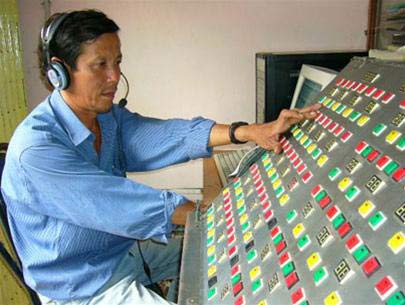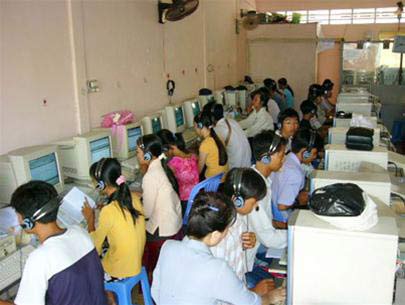It’s not about standing and lecturing for hours that allows a teacher to guide both theory and practice for a computer class of 40 students with completely different sections… This is thanks to the “teaching machine” created by Nguyễn Ngọc Hùng (Soc Trang Town, Soc Trang Province).
Hùng graduated from the Mathematics Pedagogy program at Can Tho University and served as a lecturer at Hau Giang University while still very young. In 1990, he was sent by the university to the University of Economics in Ho Chi Minh City to study programming.
 |
| Nguyễn Ngọc Hùng is on duty next to the ‘teaching machine’ to answer students’ questions (Photo: TTO) |
Those were the days Hùng was excited to “experiment” with the computer. In 1994, he successfully invented a feather classification machine and an electronic ballast that prevented flickering in fluorescent lights when the power was weak.
Hùng recalls: “I lost sleep over creating the feather classification machine, but I only earned 30,000 dong for it. As for the electronic ballast, the partner paid me with… one and a half taels of gold.”
After facing a few failures with his plans, Hùng decided to stop teaching. In 1996, he opened an electronic and computer repair shop to make ends meet. At that time, in Soc Trang, there were only a handful of people skilled in computers, so Hùng began to think about returning to teaching by offering private computer lessons.
With financial support from friends, Hùng opened a computer teaching facility on Le Hong Phong Street, Soc Trang Town. His daily routine was hectic, working from early morning until nearly midnight. “That’s why I thought I needed to create a teaching machine for myself,” Hùng confided.

Computer class taught using the ASIS model through the ‘teaching machine’
of Nguyễn Ngọc Hùng
With this idea, Hùng plunged into research and consulted software to build a teaching system.
His solution was to combine custom-built hardware with software to transmit images and sound, control students’ computers remotely, and enable information exchange between teachers and students.
After two years of teaching and researching, Hùng finally developed an automatic interactive learning model called ASIS (Auto Study Interactive System). He did not hesitate to start “crafting” a “teaching machine” with a total investment of nearly 200 million dong.
Hùng stated: “Thanks to the two-way audio system, when students have questions, they just need to press a button, and the signal light on the control unit will blink. Through the server, the teacher will connect to exchange and guide students outside.”
According to this model, Hùng’s lectures have been pre-programmed into the machine. Students can come to his facility to learn at any time. “They just need to turn on the machine, and they can listen to the theory while applying it to solve exercises. If they don’t understand a part, they can rewind and listen to the lecture multiple times, and if needed, they can chat online with the teacher sitting inside,” Hùng explained.
In addition to teaching computer skills, Hùng has utilized this teaching machine to teach English to hundreds of young individuals, achieving significant initial success.
NGỌC DIỆN


















































